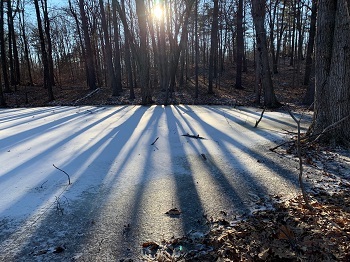Amphibian Migrations - Jefferson Salamander, Migration Update
The New York State Department of Environmental Conservation sent this bulletin on 02/21/2022 12:05 PM EST |
| DEC Delivers - Information to keep you connected and informed from the NYS Department of Environmental Conservation |
| Share or view as a web page || Update preferences or unsubscribe |
Amphibian Migrations and Road CrossingsA Project of the NYSDEC Hudson River Estuary Program and Cornell University |
|
In this issue:
Celebrating Jefferson SalamanderToday seemed an appropriate day to consider Jefferson salamander (Ambystoma jeffersonianum). Described by J. Green in 1827, the salamander was named after Jefferson College, which was near the location the species was first observed. (The Pennsylvania college is named after President Thomas Jefferson.) Photo below of an adult Jefferson-blue spotted salamander complex during migration by S. Stanne.
Jefferson salamander...
Photo above of an adult "leadback" during migration by L. Heady. Note the slender body and tiny feet. Migration Update: February 17
Although there is a warming trend today with rain in the forecast tomorrow, I think the chance of migration is low since temperatures will drop below freezing again tonight. That said, intrepid volunteers are encouraged to look for early movement of migrating amphibians and report back! There is always local variability, so check the forecast and conditions before donning your safety vest and headlamp. Final Reminder! Virtual Volunteer Training on February 22If you are a new AM&RC volunteer or a former volunteer in need of a refresher, please join us for a virtual training tomorrow at 5-6:15pm. Click here for more information and to register. There are also lots of resources for volunteers on the project webpage. Subscribe for AM&RC BulletinsDid someone forward this email to you? If you'd like to subscribe to receive AM&RC news and migration updates yourself, click here to sign up. Thanks in advance for taking safety measures during migration surveys and for your ongoing interest in conserving Hudson Valley biodiversity! Best, Laura Heady The Amphibian Migrations and Road Crossings project is part of a larger Hudson River Estuary Program initiative to partner with local communities to conserve natural areas and habitats that sustain the health and resiliency of the entire estuary watershed. |



 Several of us checked known road crossings for migration last Thursday night, and as far south as Westchester County, there were no wood frog, mole salamander species, or spring peepers to be found (or heard). It's still very early and in many locations, the ground and wetlands are frozen. When I checked vernal pools in Ulster County below 200-foot elevation yesterday, they were solid ice (see photo, right).
Several of us checked known road crossings for migration last Thursday night, and as far south as Westchester County, there were no wood frog, mole salamander species, or spring peepers to be found (or heard). It's still very early and in many locations, the ground and wetlands are frozen. When I checked vernal pools in Ulster County below 200-foot elevation yesterday, they were solid ice (see photo, right).